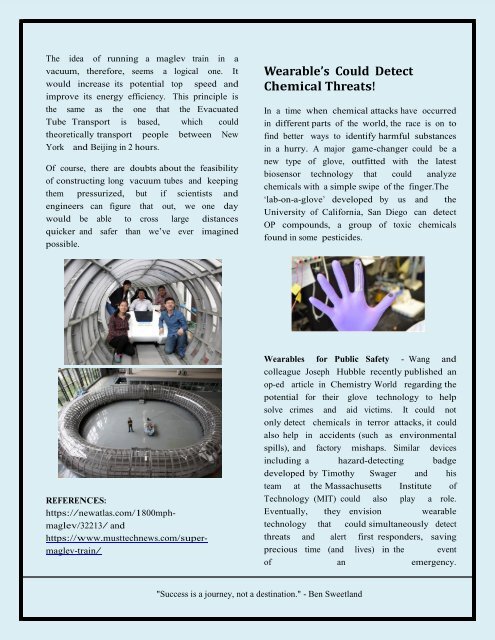You also want an ePaper? Increase the reach of your titles
YUMPU automatically turns print PDFs into web optimized ePapers that Google loves.
The idea of running a maglev train in a<br />
vacuum, therefore, seems a logical one. It<br />
would increase its potential top speed and<br />
improve its energy efficiency. This principle is<br />
the same as the one that the Evacuated<br />
Tube Transport is based, which could<br />
theoretically transport people between New<br />
York and Beijing in 2 hours.<br />
Of course, there are doubts about the feasibility<br />
of constructing long vacuum tubes and keeping<br />
them pressurized, but if scientists and<br />
engineers can figure that out, we one day<br />
would be able to cross large distances<br />
quicker and safer than we’ve ever imagined<br />
possible.<br />
Wearable’s Could Detect<br />
Chemical Threats!<br />
In a time when chemical attacks have occurred<br />
in different parts of the world, the race is on to<br />
find better ways to identify harmful substances<br />
in a hurry. A major game-changer could be a<br />
new type of glove, outfitted with the latest<br />
biosensor technology that could analyze<br />
chemicals with a simple swipe of the finger.The<br />
‘lab-on-a-glove’ developed by us and the<br />
University of California, San Diego can detect<br />
OP compounds, a group of toxic chemicals<br />
found in some pesticides.<br />
REFERENCES:<br />
https://newatlas.com/1800mphmaglev/32213/<br />
and<br />
https://www.musttechnews.com/supermaglev-train/<br />
Wearables for Public Safety - Wang and<br />
colleague Joseph Hubble recently published an<br />
op-ed article in Chemistry World regarding the<br />
potential for their glove technology to help<br />
solve crimes and aid victims. It could not<br />
only detect chemicals in terror attacks, it could<br />
also help in accidents (such as environmental<br />
spills), and factory mishaps. Similar devices<br />
including a hazard-detecting badge<br />
developed by Timothy Swager and his<br />
team at the Massachusetts Institute of<br />
Technology (MIT) could also play a role.<br />
Eventually, they envision wearable<br />
technology that could simultaneously detect<br />
threats and alert first responders, saving<br />
precious time (and lives) in the event<br />
of an emergency.<br />
"Success is a journey, not a destination." - Ben Sweetland





